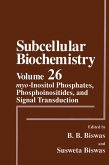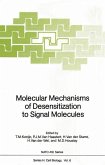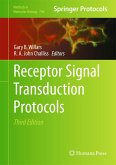Biological Signal Transduction
Herausgegeben von Ross, Elliott M.; Wirtz, Karel W.A.
Biological Signal Transduction
Herausgegeben von Ross, Elliott M.; Wirtz, Karel W.A.
- Broschiertes Buch
- Merkliste
- Auf die Merkliste
- Bewerten Bewerten
- Teilen
- Produkt teilen
- Produkterinnerung
- Produkterinnerung
Providing a survey on current research in eukaryotic signal transduction, some of the topics covered are, the biochemistry and biophysics of cell surface receptors, G-protein mediated signalling pathways, regulation of cyclic AMP, Ca2+, inositol phosphate pathways, the structure and regulation of receptors which are tyrosine protein kinases, and cellular responses to integrated signals.
Andere Kunden interessierten sich auch für
![Signal Transduction by Reactive Oxygen and Nitrogen Species: Pathways and Chemical Principles Signal Transduction by Reactive Oxygen and Nitrogen Species: Pathways and Chemical Principles]() FormanSignal Transduction by Reactive Oxygen and Nitrogen Species: Pathways and Chemical Principles121,99 €
FormanSignal Transduction by Reactive Oxygen and Nitrogen Species: Pathways and Chemical Principles121,99 €![Signal Transduction by Reactive Oxygen and Nitrogen Species: Pathways and Chemical Principles Signal Transduction by Reactive Oxygen and Nitrogen Species: Pathways and Chemical Principles]() Signal Transduction by Reactive Oxygen and Nitrogen Species: Pathways and Chemical Principles121,99 €
Signal Transduction by Reactive Oxygen and Nitrogen Species: Pathways and Chemical Principles121,99 €![Oxidative Stress and Signal Transduction Oxidative Stress and Signal Transduction]() Henry J. FormanOxidative Stress and Signal Transduction154,99 €
Henry J. FormanOxidative Stress and Signal Transduction154,99 €![Oxidative Stress and Signal Transduction Oxidative Stress and Signal Transduction]() Henry J. FormanOxidative Stress and Signal Transduction161,99 €
Henry J. FormanOxidative Stress and Signal Transduction161,99 €![myo-Inositol Phosphates, Phosphoinositides, and Signal Transduction myo-Inositol Phosphates, Phosphoinositides, and Signal Transduction]() myo-Inositol Phosphates, Phosphoinositides, and Signal Transduction81,99 €
myo-Inositol Phosphates, Phosphoinositides, and Signal Transduction81,99 €![Molecular Mechanisms of Desensitization to Signal Molecules Molecular Mechanisms of Desensitization to Signal Molecules]() Molecular Mechanisms of Desensitization to Signal Molecules81,99 €
Molecular Mechanisms of Desensitization to Signal Molecules81,99 €![Receptor Signal Transduction Protocols Receptor Signal Transduction Protocols]() Receptor Signal Transduction Protocols77,99 €
Receptor Signal Transduction Protocols77,99 €-
-
-
Providing a survey on current research in eukaryotic signal transduction, some of the topics covered are, the biochemistry and biophysics of cell surface receptors, G-protein mediated signalling pathways, regulation of cyclic AMP, Ca2+, inositol phosphate pathways, the structure and regulation of receptors which are tyrosine protein kinases, and cellular responses to integrated signals.
Hinweis: Dieser Artikel kann nur an eine deutsche Lieferadresse ausgeliefert werden.
Hinweis: Dieser Artikel kann nur an eine deutsche Lieferadresse ausgeliefert werden.
Produktdetails
- Produktdetails
- Nato ASI Subseries H: 52
- Verlag: Springer / Springer Berlin Heidelberg / Springer, Berlin
- Artikelnr. des Verlages: 978-3-642-75138-7
- Softcover reprint of the original 1st ed. 1991
- Seitenzahl: 560
- Erscheinungstermin: 23. Dezember 2011
- Englisch
- Abmessung: 242mm x 170mm x 30mm
- Gewicht: 946g
- ISBN-13: 9783642751387
- ISBN-10: 3642751385
- Artikelnr.: 36115642
- Herstellerkennzeichnung Die Herstellerinformationen sind derzeit nicht verfügbar.
- Nato ASI Subseries H: 52
- Verlag: Springer / Springer Berlin Heidelberg / Springer, Berlin
- Artikelnr. des Verlages: 978-3-642-75138-7
- Softcover reprint of the original 1st ed. 1991
- Seitenzahl: 560
- Erscheinungstermin: 23. Dezember 2011
- Englisch
- Abmessung: 242mm x 170mm x 30mm
- Gewicht: 946g
- ISBN-13: 9783642751387
- ISBN-10: 3642751385
- Artikelnr.: 36115642
- Herstellerkennzeichnung Die Herstellerinformationen sind derzeit nicht verfügbar.
Specialists in biochemistry and cell biology of cellular communication give an overview of current knowledge in this field.
I. Receptor Characteristics, Function and Regulation.- The nicotinic acetylcholine receptor: a member of the superfamily of ligand-gated ion channels.- Epidermal growth factor receptor autophosphorylation is not required for normal mitogenic or transforming signal generation.- The epidermal growth factor receptor: receptor dimerization and signal transduction.- Dimerization activates the epidermal growth factor receptor tyrosine kinase.- Insulin-related peptides and their receptor(s) in the mollusc, Lymnaea stagnalis.- Hepatic vasopressin receptor: a key receptor of phosphoinositide metabolism.- Gene targeting by homologous recombination as a tool to study the biophysical role of the interferon-? signalling pathway.- Expression of novel cloned rat pituitary receptors in mammalian cells.- Cellular localization of seven transmembrane domain receptor mRNA's by in-situ hybridization.- The T cell activation molecule CD27 is a member of the nerve growth factor receptor gene family.- Membrane receptor clustering as a cellular stimulus - the mast cell case.- II. G-Proteins and Protein Kinases.- G protein-coupled receptors: structural basis of selective signaling.- Hormone receptor-effector coupling in prolactin producing pituitary cell lines (GH cells)..- Effect of aging on the ?-adrenergic signal transduction system in rat kidney, lung, and mononuclear leukocytes.- The transducin cycle in the phototransduction cascade.- Expression of two isoforms of the guanine nucleotide binding protein, G0, in NG108-15 neuroglioma cells.- Mechanisms underlying hormonal modification of dopamine receptor sensitivity.- Phosphorylation of the growth factor activatable Na+/H+ antiporter: a mechanism of regulation.- Overexpression of protein kinase C ? in Swiss/3T3 cells reduces thenumber of both high and low affinity of the epidermal growth factor receptors.- Characterization of protein kinase C isoforms in a small cell lung carcinoma cell line: regulation of PKC? and its catalytic fragment.- The human type I cGMP-dependent protein kinase gene.- Control of cellular activity by protein phosphorylation-dephosphorylation: Phosphorylase kinase from bovine stomach smooth muscle.- III. Surface Membrane Components.- Properties of phosphoinositides in membranes.- Glycosyl-phosphatidylinositol membrane anchors.- Cell adhesion in morphogenesis.- IV. Inositol Phosphate and Calcium.- Inositol phosphate metabolism and function.- Inositol 1,4,5-triphosphate and inositol 1,3,4,5-tetrakiphosphate: functions, metabolism and interconversion.- Histamine H1-receptor-mediated breakdown of inositol phospholipids in primary neuronal cultures.- Intracellular Ca2+ homeostasis: receptor-activated Ca2+ channels and intracellular Ca2+ pools.- Multiple sources of sn-1,2-diacylglycerol in mitogen-stimulated Swiss 3T3 cells: evidence for activation of phosphoinositidase C and phospholipase D.- Phorbol esters and muscarinic receptor agonists activate phospholipase D in heart and brain.- V. Release Reactions and Protein Sorting.- Development of a single cell Ca2+ imaging system to study the role of PKC substrate B-50 in neurotransmitter release and neurite outgrowth.- Regulated exocytosis as a paradigm of biological signal transduction.- Mannose 6-phosphate receptors and their role in protein sorting along the pathway to lysosomes.- Protein sorting in endosomes.- VI. Addendum.- Note to the addendum.- Guanylate cyclase in signal transduction of Dictyosteliwn a iscoideum.- Epidermal growth factor mediated signal transduction in rat hepatocytes.
I. Receptor Characteristics, Function and Regulation.- The nicotinic acetylcholine receptor: a member of the superfamily of ligand-gated ion channels.- Epidermal growth factor receptor autophosphorylation is not required for normal mitogenic or transforming signal generation.- The epidermal growth factor receptor: receptor dimerization and signal transduction.- Dimerization activates the epidermal growth factor receptor tyrosine kinase.- Insulin-related peptides and their receptor(s) in the mollusc, Lymnaea stagnalis.- Hepatic vasopressin receptor: a key receptor of phosphoinositide metabolism.- Gene targeting by homologous recombination as a tool to study the biophysical role of the interferon-? signalling pathway.- Expression of novel cloned rat pituitary receptors in mammalian cells.- Cellular localization of seven transmembrane domain receptor mRNA's by in-situ hybridization.- The T cell activation molecule CD27 is a member of the nerve growth factor receptor gene family.- Membrane receptor clustering as a cellular stimulus - the mast cell case.- II. G-Proteins and Protein Kinases.- G protein-coupled receptors: structural basis of selective signaling.- Hormone receptor-effector coupling in prolactin producing pituitary cell lines (GH cells)..- Effect of aging on the ?-adrenergic signal transduction system in rat kidney, lung, and mononuclear leukocytes.- The transducin cycle in the phototransduction cascade.- Expression of two isoforms of the guanine nucleotide binding protein, G0, in NG108-15 neuroglioma cells.- Mechanisms underlying hormonal modification of dopamine receptor sensitivity.- Phosphorylation of the growth factor activatable Na+/H+ antiporter: a mechanism of regulation.- Overexpression of protein kinase C ? in Swiss/3T3 cells reduces thenumber of both high and low affinity of the epidermal growth factor receptors.- Characterization of protein kinase C isoforms in a small cell lung carcinoma cell line: regulation of PKC? and its catalytic fragment.- The human type I cGMP-dependent protein kinase gene.- Control of cellular activity by protein phosphorylation-dephosphorylation: Phosphorylase kinase from bovine stomach smooth muscle.- III. Surface Membrane Components.- Properties of phosphoinositides in membranes.- Glycosyl-phosphatidylinositol membrane anchors.- Cell adhesion in morphogenesis.- IV. Inositol Phosphate and Calcium.- Inositol phosphate metabolism and function.- Inositol 1,4,5-triphosphate and inositol 1,3,4,5-tetrakiphosphate: functions, metabolism and interconversion.- Histamine H1-receptor-mediated breakdown of inositol phospholipids in primary neuronal cultures.- Intracellular Ca2+ homeostasis: receptor-activated Ca2+ channels and intracellular Ca2+ pools.- Multiple sources of sn-1,2-diacylglycerol in mitogen-stimulated Swiss 3T3 cells: evidence for activation of phosphoinositidase C and phospholipase D.- Phorbol esters and muscarinic receptor agonists activate phospholipase D in heart and brain.- V. Release Reactions and Protein Sorting.- Development of a single cell Ca2+ imaging system to study the role of PKC substrate B-50 in neurotransmitter release and neurite outgrowth.- Regulated exocytosis as a paradigm of biological signal transduction.- Mannose 6-phosphate receptors and their role in protein sorting along the pathway to lysosomes.- Protein sorting in endosomes.- VI. Addendum.- Note to the addendum.- Guanylate cyclase in signal transduction of Dictyosteliwn a iscoideum.- Epidermal growth factor mediated signal transduction in rat hepatocytes.








